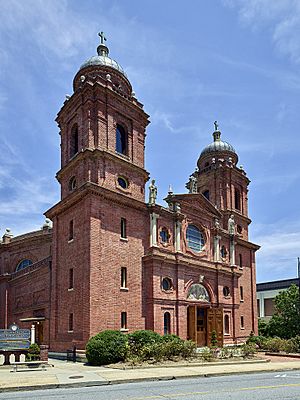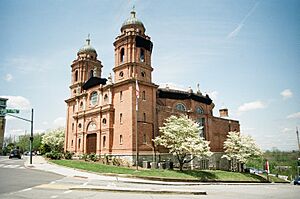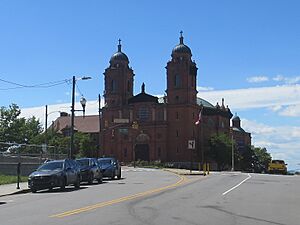Basilica of St. Lawrence, Asheville facts for kids
Quick facts for kids The Minor Basilica of Saint Lawrence |
|
|---|---|

Principal Facade, Basilica of St. Lawrence
|
|
| Religion | |
| Affiliation | Catholic Church |
| District | Diocese of Charlotte |
| Leadership | Rev. Mgsr. Roger Arnsparger, Rector |
| Status | Minor Basilica |
| Location | |
| Location | Asheville, North Carolina, United States |
| State | North Carolina |
| Architecture | |
| Architect(s) | Rafael Guastavino Richard Sharp Smith |
| Architectural style | Spanish Renaissance architecture |
| Completed | 1909 |
The Minor Basilica of St. Lawrence the Deacon & Martyr is a special Catholic Church building in downtown Asheville, North Carolina, United States. It was designed and built in 1905 by a Spanish architect named Rafael Guastavino. He worked with another architect, R. S. Smith, and the local Catholic community.
In 1993, Pope John Paul II gave the church the special title of "minor basilica." This means it's an important church with close ties to the Pope. It is the only basilica in western North Carolina. The church is also listed on the National Register of Historic Places, which means it's a very important historical site.
One of the most amazing parts of the basilica is its large dome. It was inspired by a church in Spain. This dome is thought to be the biggest freestanding, oval-shaped dome in North America. It measures about 58 by 82 feet (17.7 by 25 meters). The building's style is called Spanish Renaissance architecture. It is located in the Downtown Asheville Historic District.
Contents
Inside the Basilica
The inside of the basilica is filled with beautiful art and decorations. You can see statues of many saints, like St. Lawrence, St. Cecilia, and St. Patrick. These statues were made in Italy by the Daprato Statue Company.
The main altar is made from Tennessee marble. Above it, there is a Spanish wood carving showing the Virgin Mary and John the Apostle at the crucifixion of Christ. Behind this carving, the entire wall is covered with colorful, clay decorations. These decorations show the Four Evangelists and the Archangels St. Raphael and St. Michael.
Colorful Stained Glass Windows
The basilica is famous for its many detailed stained glass windows. Many of these windows were made in Munich, Germany.
On the right side of the church, the windows show important Bible stories. These include the Annunciation of the Blessed Virgin Mary (when an angel told Mary she would have Jesus). They also show the Nativity of Christ (Jesus' birth) and the Conversion of Saint Paul.
On the left side, the windows show other stories. You can see the Wedding at Cana (where Jesus turned water into wine). There's also a window of Jesus calming the wind and waves. Another window shows the Resurrected Christ appearing to St. Mary Magdalene.
Two very large windows, one on the east and one on the west wall, show Jesus healing people and the Transfiguration of Christ. The big window in the organ area shows the Resurrection of Christ.
Special Chapels
There are two smaller chapels located on either side of the main altar.
Chapel of Our Lady
The first chapel, on the left, is called the "Chapel of Our Lady." It has a marble altar dedicated to the Virgin Mary. There is a statue of the Immaculate Conception with two angels. The front of this altar has carvings of several female saints.
Around the altar, there are tiles with names of the Blessed Virgin Mary. In the middle, there is a piece of Italian marble showing the Nativity of Christ. Above the altar, seven doves represent the Seven Gifts of the Holy Spirit.
This chapel also has icons (religious pictures) of the Blessed Virgin Mary from different traditions. These include Our Lady of Czestochowa and Our Lady of Guadalupe. You can also see votive candles under each icon. The two stained glass windows in this chapel show Our Lady, Star of the Sea and Saint Raphael the Archangel. In the back of this chapel, you can find the burial place of architect Rafael Guastavino.
Eucharistic Adoration Chapel
The second chapel, on the right, is called the "Eucharistic Adoration Chapel." It was first named the "Chapel of St. Joseph." This chapel is a quiet place for Eucharistic adoration and private prayer. The Holy Eucharist is shown on the altar for people to pray and meditate.
The stained-glass window above this altar shows the Nativity of Christ. Another window on the eastern wall shows the death of Saint Joseph with Jesus Christ and the Blessed Virgin Mary. A smaller window in the chapel shows Saint Lawrence, the saint the basilica is named after. The altar and part of the wall in this chapel are covered in a mosaic. This mosaic was made from small pieces of tile by two priests, Rev. Peter Marion and Rev. Patrick Marion, during the basilica's construction.
Around the Basilica
The basilica grounds include a rectory, which is where the priest lives. There is also a Catholic library and a gift shop for visitors. These are open after weekend church services. Behind the basilica, you can find a peaceful Mary garden. It has a life-sized white statue of the Blessed Virgin Mary.
Keeping the Basilica Strong
In 2010, the National Park Service said the church was a place of "National Significance." This was because of its amazing design and engineering. A report from the church estimated that the basilica brings about $30 million to the area through tourism.
As of August 2025, the Asheville Citizen-Times newspaper reported that the historic building had "significant damage." It needed urgent repairs both inside and out. The basilica had problems like water leaks and falling stone due to old mortar. Its copper dome also needed to be replaced because it had reached the end of its life.
The church needed better ways to collect rainwater and a new cornice (a decorative molding). The church parish raised $3 million for repairs. The Basilica Preservation Fund received another $1 million, including $750,000 from a program called Save America's Treasures. This grant was announced in August 2024.
Even with these funds, an additional $2 million was needed for just the first part of the repairs. The full restoration of the basilica is expected to cost $23 million and take about 10 years. A company from New York City, John G. Waite Associates, is helping with this big project.
Images for kids
-
Inside the structure of the dome is the tomb of Rafael Guastavino
See also
 In Spanish: Basílica de San Lorenzo (Asheville) para niños
In Spanish: Basílica de San Lorenzo (Asheville) para niños











